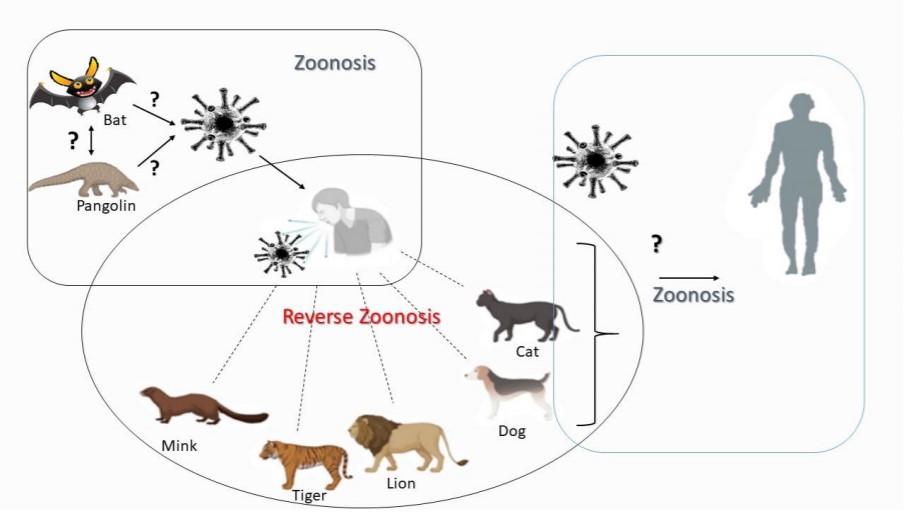Nowadays, we are fighting with the biggest pandemic of a decade. It has been more than a year passed and the world is still fighting the pandemic SARS-CoV-2 virus. SARS-CoV-2 has a genome similarity of 96 percent to a SARS-related bat coronavirus and 92 percent to a pangolin coronavirus although the link of origin of the novel virus is still missing. There is no doubt that the virus been originated from wildlife.
The newly emerged, SARS-CoV-2 is a betacoronavirus, which is different from the discovered other human and animal coronavirus to date. It named as SARS-CoV-2 based on genetically clusters with hundreds of CoVs within the species SARS-related CoVs, subgenus Sarbecovirus, genus betacoronavirus. within the last 20 years, betacoronavirus cause multiple human epidemic and pandemic disease which includes severe acute respiratory syndrome (SARS), Middle East respiratory syndrome (MERS). Horseshoe bat in the genus rhinolophus and palm civets have been identified as a natural reservoir, where viruses live and reproduce without causing disease for those animals. Dromedary camel has been identified as a natural reservoir host for MERS.
There are several cases that have been reported in zoo animals with natural occurrence of SARS-CoV2 from humans. The first wild-animal case was found in Bronx Zoo USA, a four-year-old Malayan tiger named Nadia was tested for the virus that causes COVID-19, and symptoms were begun with the loss of appetite and followingly she developed a dry cough. The female snow leopard, NeeCee, tested positive for the COVID-19 in December. Subsequently, two male snow leopards, Kimti and Meru were found positive, according to the Louisville Zoo. Based on data from the U.S. department of Agriculture, three western lowland gorillas at the San Diego Zoo have tested positive for the coronavirus. Total seven animal species reported natural SARS-CoV-2 infections which includes tigers, lions, mink, gorillas, snow leopards, dogs, and domestic cats.
Minks shows a high susceptibility to SARS-CoV-2. Several outbreaks in minks farm have been reported on Netherlands, Spain, and US. Natural SARS-CoV-2 infection in captive farmed mink in the Netherlands confirmed the possibilities of human-to-animal, animal-to-animal, and animal-to-human transmission. To avoid possible mutation of virus in minks and emerge new strain, infected animals were buried with precautions to avoid an outbreak.
Pangolin coronaviruses have been identified with 92 percent full genome sequence similarity to SARSCoV-2, and 97.4 percent amino acid sequence similarity to SARSCoV-2 supporting the hypothesis that pangolins might be the host of SARS-CoV-2 virus, or it could be recent common ancestor. So, it could be a potential source for human and animal exposure regardless of if they are infected in their natural habitat or acquired infection in a contaminated environment owing to anthropogenic activities.
According to the predictive modeling of the strength of binding and potential susceptibility of ACE2 proteins and TMPRSS2 (Transmembrane Protease, Serine 2 enzyme) with SARS-CoV-2, different animals were found susceptible. Till date there is no evidence of betacoronavirus detection was reported in wild birds except for one study from Brazil where betacoronavirus RNA in wild birds preying on bats. Analysis of key amino acid residues of ACE2 of 79 wild birds demonstrated a very low likelihood of binding SARS-CoV-2 and in the experimental infection of SARS-CoV-2 turkey, quail, chicken, ducks, and geese were found unsusceptible.
According to the new studies, there are a total of 15 mammal species identified that could be susceptible to the SARS-CoV-2 virus with the contact of wastewater although there is there are no documented cases of SARS-CoV-2 in marine mammals till date. Most marine mammals are social animals, so it is also possible for the spread of coronaviruses between animals through close contact. Nowadays it has been challenging to control SARS-CoV-2 in human populations, what if it will spread to wild mammals? It is not possible to ask animals to wear a face masks and avoid a physical distance they can sick and form a reservoir from which they can then again infect humans. Similarly, it is not possible to provide intensive care like a human being. What if virus get mutation during circulating among the wildlife and again enter the human population with updated version! There are lots of possibilities with what if but here we must consider that continues serological and antigen surveillance within the wildlife for SARS-CoV-2 will provide us better understanding of nature of virus, natural animal infections and reverse zoonosis capacity of virus. That is very important for wildlife conservation point of view.


